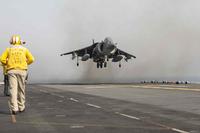UPDATED: Lockheed Details Test Results; Raytheon Faring Better So Far
Put $5 billion on the table, factor in shrinking budgets, add the fact that you are competing for what is likely to be the last tactical missile competition for the next quarter of a century and you've got one hell of a fight for the Joint Air to Ground Missile (JAGM).
The weapon system that results will replace the Maverick on F/A-18 E/F, as well as the Hellfire and missiles on the Army’s AH-64D Apache attack helicopter, the Army’s Extended Range Multi-Purpose Sky Warrior unmanned aerial system, the Marine’s AH-1Z Super Cobra attack helicopter, and the Navy’s MH-60R Seahawk. On top of that, it may be used for the Joint Strike Fighter program. IOC is scheduled on the AH-64D, AH-1Z and F/A-18E/F for 2016. If all goes as currently planned, the program will produce 33,000 missiles over the next 20 years. For those who follow acquisition closely, this is the successor program to the deeply troubled Joint Common Missile.
On one side of the missile corral stands mighty Lockheed Martin. Facing the largest defense company in America is a team of Raytheon and Boeing. JAGM is a test for the companies, as well as the Pentagon, being the first of two programs set up by former head of acquisition John Young as a test of his prototyping approach: prove to the Pentagon that you can actually build what you say you can build by building a few successful models that can meet some test requirements.
The importance of a success for a significant joint program can't be overstated. One after another of programs called joint have disappointed, failed or been cancelled. "Joint programs have not enjoyed a great deal of success in the past," said Mike Riley, head of JAGM business development at Raytheon.
Raytheon paid for two missile test shots in April to see if they were on the right path. On 23 June, they fired the first test shot supervised and scored by the government at White Sands Missile Range. A second shot is coming Aug. 13.
So far, the Raytheon team has scored, well, "perfectly," according to Riley.
The technical challenges are daunting for both competitors. The rocket motor must be able to operate in temperatures up to 140 degrees Fahrenheit and operate without a contrail that might blind a helicopter pilot and, for fixed-wing aircraft; it must remain operational at minus 65 degrees. This is, as they say, rocket science.
One advantage Raytheon boasts is an infrared seeker that does not depend on a cooling system to help it distinguish targets. That should mean substantially less maintenance and weight.
Lockheed has not fared as well in the test shots. Here's what the company sent in response to questions.
To date, Lockheed Martin has fired 2 of the 3 shots, the SAL and I2R.The SAL shot was Monday, August 2:
Lockheed Martin’s Joint Air-to-Ground Missile (JAGM) testing is ongoing, with a highly successful test flight of its semi-active laser (SAL) seeker on August 2 at White Sands Missile Range, NM. The 16-kilometer shot was the first flight test under the JAGM Technology Development contract, testing the three JAGM sensors in the missile’s tri-mode seeker. The JAGM missile scored a direct hit on the target board in the test.
The I2R shot was Tuesday, August 3:
Lockheed Martin conducted a JAGM flight test on August 3 at White Sands Missile Range, NM, against a tank target at 4 km to test the missile’s imaging infrared (I2R) seeker. The missile launched successfully and indications are that the missile initially guided to the target but overshot it. We are analyzing the flight test data to isolate the precise cause of the anomaly. We will then take immediate corrective action so we can proceed to validate the performance of the I2R and subsequently the millimeter wave (MMW) sensors during our next round of testing in September.
Lockheed Martin is confident we will meet the government’s requirement for the three successful test firings with intercepts within the schedule.
Lockheed Martin also conducted two Flight Readiness Checks during the months of June/July:
A government check which was declared a no-test due to a range instrumentation malfunction. (That missile was scheduled to August 2 and produced the successful SAL shot mentioned earlier)
A Lockheed Martin-funded effort which was a no-test due to a pre-launch malfunction.
Lockheed Martin’s JAGM cooled-seeker technology provides superior resolution and performance unmatched by alternative solutions. The open architecture and modular design enable future capabilities to be seamlessly inserted into our JAGM system, and we have an extensive legacy of proven platform integration experience. As the world’s leading provider of precision engagement systems, we look forward to providing this critical capability to the nation’s Warfighters.








